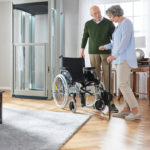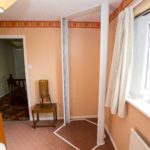This comprehensive guide by the Homelift Experts is an exhaustive look at everything that a homeowner needs to know about home lifts, making it a go-to resource for anyone considering installing a lift in the home.
Introduction to Home Lifts
 A home lift is a domestic lift installation in your home that enables you to traverse the different floors of your home at the push of a button.
A home lift is a domestic lift installation in your home that enables you to traverse the different floors of your home at the push of a button.
Just as you would use an elevator in a hotel, shopping centre or department store, a through-floor lift is a safe, secure, and comfortable way to move around your home, removing the discomfort and risks associated with using the stairs.
Brief History and Evolution of Domestic Lifts
Home lifts are not a new concept, there is evidence of their use dating back to the Roman times. Archimedes, a Greek mathematician and creative inventor came up with an ingenious lift-type contraption using animals and hemp rope. However, more recently a desire to create a stylish replacement for the medical-looking stairlifts led the way for modern domestic home lifts.
These residential lifts changed the game with compact, elegant, quiet, and cost-effective options that for some brands can use cutting-edge technology and are self supporting.
Some plug straight into a regular wall socket and use the same amount of power to operate as a domestic toaster or kettle. There is no need for a separate machine room, a pit shaft, or a load-bearing wall. This has exploded the domestic lifts market – making them available to everyone who needs them to feel safe, secure and at home in the home they love, and where they want to be.
No need to carry anything separately you can take mobility aids, the hoover, laundry or even the dog up or down stairs with you with ease, comfort, and style with a modern domestic lift.
Most home lifts include 12 12-month warranty and the first service as standard, meaning that you can confidently know that there will be no further costs in the foreseeable future.
Expect to book in an annual service to ensure that your domestic lift remains in tip-top condition. With quality that is built to last and well maintained your lift will last a very long time. Look for a company with an aftercare service that is always available on the phone to answer any questions you may have.
Safety Features
 You can have total peace of mind with a home lift as you will expect to see a whole range of essential safety features that meet and exceed regulatory standards and compliance.
You can have total peace of mind with a home lift as you will expect to see a whole range of essential safety features that meet and exceed regulatory standards and compliance.
Many modern lifts include built-in obstruction sensors, hold-to-run controls, weight limit and balance indicators, an emergency stop button, a key switch operation to stop unauthorised and a fall arrest mechanism system in the highly unlikely event the lift falls.
How to Choose the Right Home Lift for Your Needs
When choosing a home lift ensure you fully evaluate your specific mobility requirements now and what your future accessibility needs may be.
Consider how many floors of your home need to be served and whether it is best travelling from the living room to a main bedroom or from the hall to the landing depending on whether visitors or guests might need to use it.
In terms of design and functionality, if space is a factor, there are many home elevators that are extremely compact and modular and can fit almost anywhere.
The design aesthetic might be important to you whether you prefer your home lift to be a centrepiece or blend beautifully with your existing home décor. Design is crucial in a home lift because it impacts safety, accessibility, aesthetics, and user experience.
A well-designed lift is user-friendly, with accessible controls and entry points, making it easy for all users, including the elderly and those with disabilities, to use it independently. It also optimises space within the home, ensuring the lift fits well without compromising other areas.
Benefits of Home Lifts
 Home lifts help to improve accessibility throughout the home by making it possible to transcend the different floors of your home quickly, safely and in complete comfort. This means that you have greater access to all areas of your home without difficulty, making it more likely that you will move around more and use your home to the fullest. Increased movement is associated with increased strength and mobility. Having a lift in the home takes away the barrier that stairs create, improving the quality of life for elderly, and/or disabled residents.
Home lifts help to improve accessibility throughout the home by making it possible to transcend the different floors of your home quickly, safely and in complete comfort. This means that you have greater access to all areas of your home without difficulty, making it more likely that you will move around more and use your home to the fullest. Increased movement is associated with increased strength and mobility. Having a lift in the home takes away the barrier that stairs create, improving the quality of life for elderly, and/or disabled residents.
These residential lifts can often be a much cheaper solution than moving home or going into a care home. Most people would prefer to age in place, staying in the home that they have loved for many years, and has often been enjoyed across generations. Making your home suitable for your needs now and in the future is necessary to achieve this goal. A home lift, however, can also add significant value to your home and can make it appeal to a wider market when or if you might need to sell in the future.
Installation Tips
 Before you order your through-the-floor lift, a home lift expert should always come to your home and conduct a home survey. This will give you and your family all the information required ahead of installation day, that is specific and tailored to that particular project. It is the perfect chance for you to ask any questions you may have and discuss any optional extras or customisation.
Before you order your through-the-floor lift, a home lift expert should always come to your home and conduct a home survey. This will give you and your family all the information required ahead of installation day, that is specific and tailored to that particular project. It is the perfect chance for you to ask any questions you may have and discuss any optional extras or customisation.
On the day of installation, your provider is likely to explain any maintenance requirements, warranties and may give you a full demo so that you are confident on how to use your lift straight away.
Self-supporting lifts are typically fitted in one day, require only a small aperture and no-load bearing walls. You should expect a neat and tidy service with minimal disruption to your schedule.
Cost Considerations
 Having a home lift installed to adapt and future-proof your property is often a much more cost-effective solution than moving home, avoiding the costs of moving including stamp duty, estate agent and conveyancing solicitor fees.
Having a home lift installed to adapt and future-proof your property is often a much more cost-effective solution than moving home, avoiding the costs of moving including stamp duty, estate agent and conveyancing solicitor fees.
What is more, it is unlikely that you will find the perfect home and will likely need to make changes or adaptions to somewhere new. As such, it is often hassle-free to adapt your current home.
Funding your home lift
Home lift costs can vary considerably from provider to provider from, on average, £15,000 to £33,000. If you are considering investing in a home lift but might need to consider your options to raise additional funding, there are also several different ways to fund your home lift.
Funding grants such as Disabled Facilities Grants (DFGs) provide financial assistance for home adaptations, including home lifts. Eligibility for these grants is based on need and means-testing, and the process involves your local council, and you will require their approval before commencing any work – so factor in some time for this stage.
Another route worth exploring is the Access to Work Scheme which offers support for people living with disabilities who also work from home.
Other financial support options to explore include VAT relief, and various loan options. Several charities such as Scope UK and the Joseph Patrick Trust provide grants for home adaptations.
Some lift providers also offer financing options, making the investment more manageable. Speak to your provider regarding any opportunities during your initial conversation.


Recent Comments